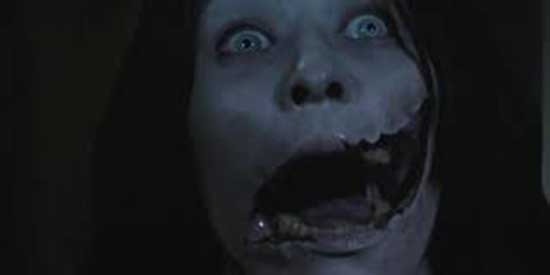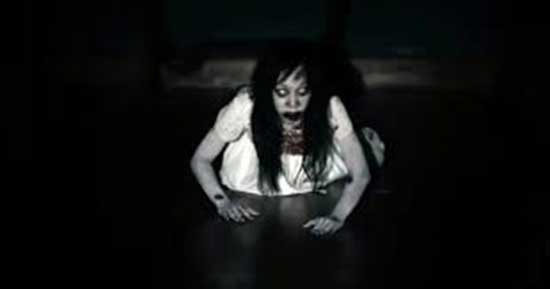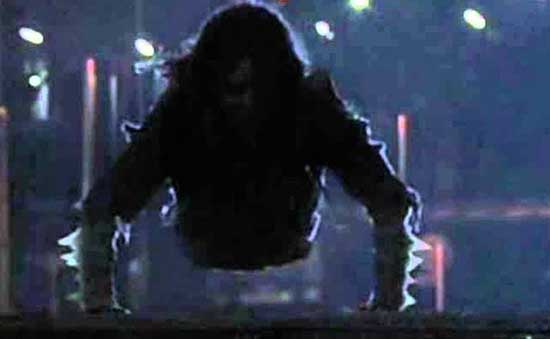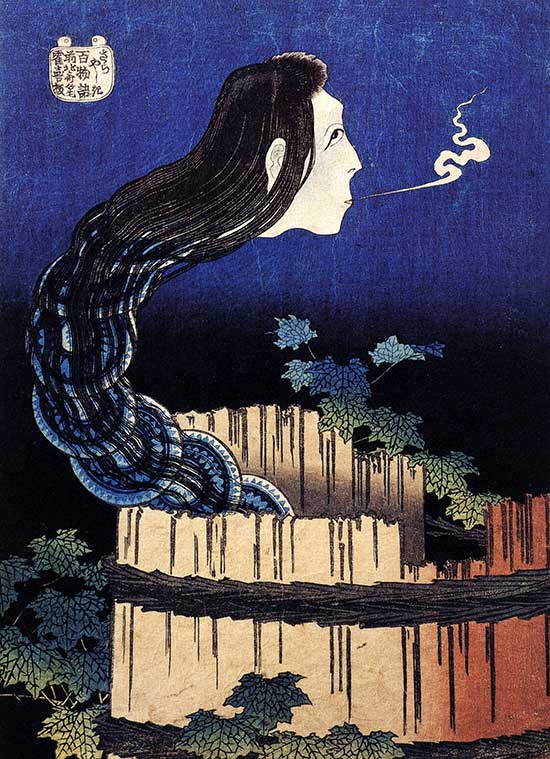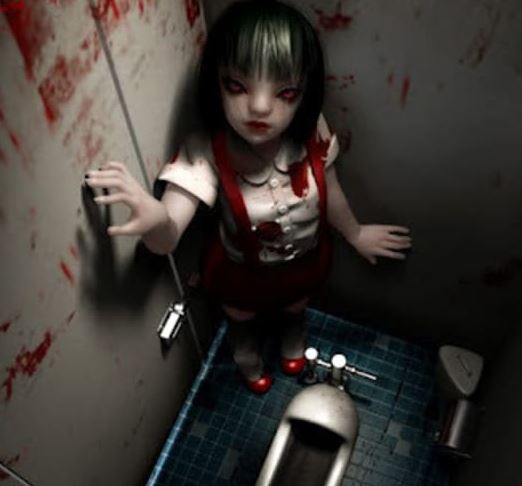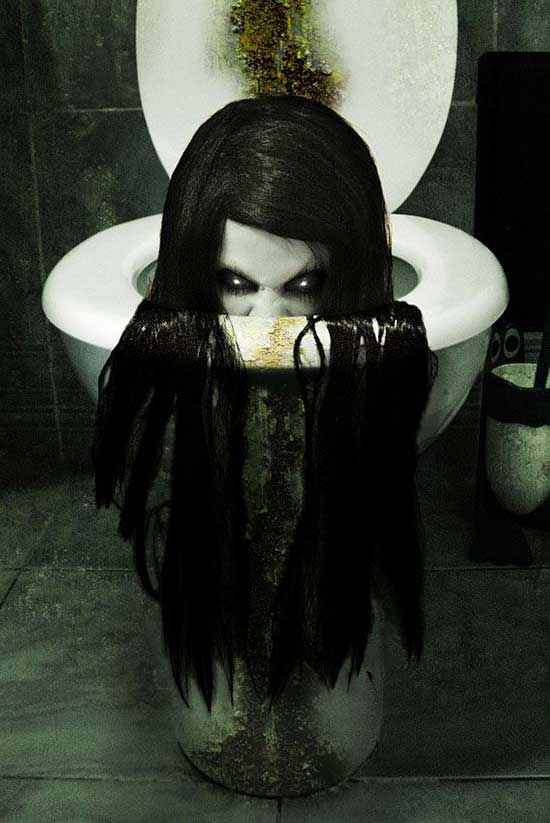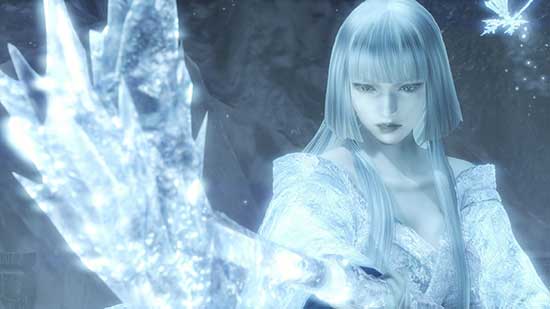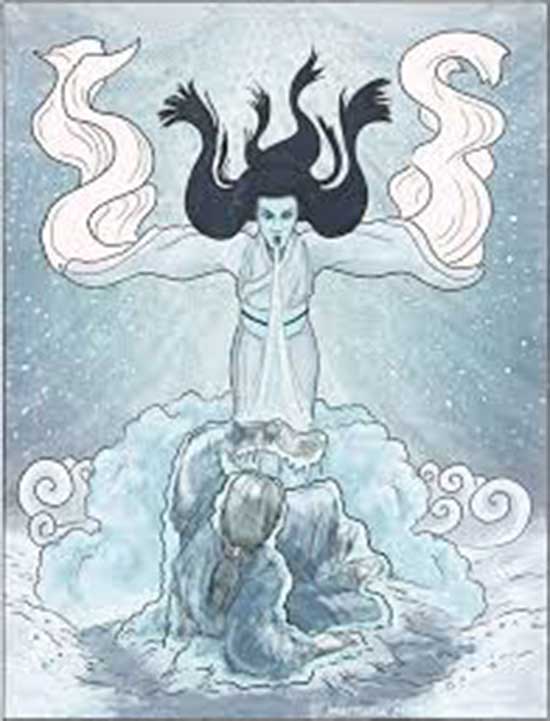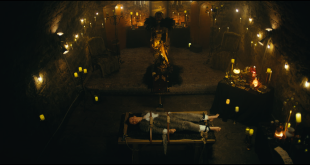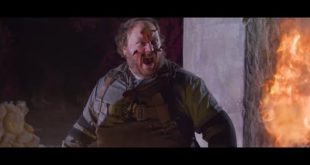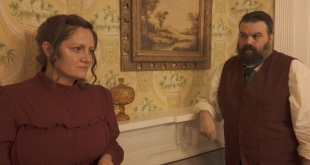2020 is shaping up to be a promising year for horror. January alone is jam-packed with all sorts of intriguing titles, such as the Lovecraftian cosmic chiller Colour Out of Space and the nautical monster romp Underwater. Further on in the year we can expect titles like The Lodge, Come to Daddy and Antebellum. An old favourite Candyman will also be making an appearance in a form of a spiritual sequel produced and co-written by Jordan Peele, and James Wan will be delighting us with Malignant; his take on the giallo genre.
Much as I definitely have an interest in all of the above and will be checking them out in due course, the title that has got me most excited is Howling Village, written and directed by none other than Takashi Shimizu. While it’s perfectly possible that I might be getting my hopes up for no good reason, after seeing the first teaser trailer and doing a bit of reading around the subject matter, all I can say is that I’m like a kid at Christmas. The story is set in a mysterious Inunaki village; a place that has laid abandoned for decades at the end of a forgotten tunnel. People brave enough to enter have a bad habit of disappearing and it is said that no one has returned alive. When a young man by the name of Yuma together with his girlfriend decide to investigate the village, Yuma’s sister, clinical psychologist Kanae, finds herself in a middle of a spooky mystery.
All that alone has absolutely piqued my interest. A haunted village where no one returns from? Sign me up please. What makes Howling Village even more intriguing though is the fact that all of this is not merely a figment of Shimizu’s imagination, but based on an actual urban legend. The real Inunaki village is said to be located somewhere in deep, dark Japanese countryside and the only entrance is through an abandoned tunnel. At the gates you will see a sign stating, “The laws and constitution of Japan do not apply here.”, apparently suggesting something about the lawless nature of the place. In some versions of the story the said lawlessness was not merely limited to the villagers making their own rules, but things like cannibalism, incest and murder were common practice. It is said that the whole village died in mysterious circumstances, some say by a disease, some by the hand of one the villagers gone mad. Whatever the case, the place is said to be haunted and extremely dangerous.
The actual story is of course something much simpler and the urban legend, as so often is the case, is a compilation of a few different stories. The real life Inunaki village is located in Miyawaka, Fukuoka Prefecture, at the bottom of the local reservoir, and the mass exodus of the villagers was not due to anything sinister, but simply a measure of relocation from underneath the new dam/reservoir. The aforementioned warning signs (that are actually located on the gates to the dam) simply warn travellers about animal traps and snakes, and not of unlawful villagers. The stories of a single village member gone mad might however have some basis in real-life, albeit not in Inunaki Village: In 1938 a young man by the name of Mutsuo Toi went on a killing spree in the village of Kamo, murdering 30 people before killing himself, thus giving inspiration to rumours of similar crimes.
While we wait for Howling Village to hit the cinemas/streaming services, why not have a look of other terrifying urban legends that Japan has to offer and more importantly, the films that they have inspired.
Kutchisake-onna
One the best know Japanese urban legends must be the tale of Kutchisake-onna, or The Slit-Mouthed Woman. According to some folklorists the legend dates as far back as the Edo period, but the beginnings of the modern urban legend are in the late 1970’s in the town of Yaotsu in Gifu Prefecture. An old farmer woman reported seeing a woman with a mouth slit from ear to ear in the corner of her garden and after a local newspaper got hold of the story a legend was born. The story of this eerie sighting was first spread amongst the local children and later on nationwide, actually causing a small panic in some towns. As all folklore, the story varies slightly from town to town, but the basic premise is a follows: a woman wearing a surgical mask and often carrying either scissors or a sickle will confront you in the street. She will ask you whether you think she is beautiful and if you answer “No” she will kill you on the spot. If you answer “Yes” she will remove her mask, showing you, her horrifically carved up face and ask, “How about now?”. Again, if your answer is “No” she will kill you by cutting you in half, and if the answer is “Yes” she will cut up your face in the same eternal smile that she has. In some versions it’s possible to escape her simply by answering “Yes” to both questions or by throwing bekkōame hard candy her way. But be warned: it is also said that even if you manage to outrun her, she will simply come and get you when you sleep.
Kutchisake-onna has naturally been a fairly popular subject in the film world. She makes an appearance in Studio Ghibli’s 1994 film Pom Poko and two years later also got her own titular short film Kutchisake-onna by Teruyoshi Ishii. The best-known version is perhaps Koji Shiraihi’s 2007 film Carved: The Slit-Mouthed Woman (Kutchisake-onna). In it the cut-up monster is not only killing her victims, but also kidnapping them, causing chaos in her wake. Two local teachers take it upon themselves to find the fiend behind these horrific crimes, one of them with a personal connection to the titular monster. Shiraishi’s Kutchisake-onna is not merely a supernatural beast, but as we find out, was a monster of a different ilk when alive, bringing the real-life horrors of child abuse and neglect to the centre of the story. This little add, while horrific in a completely different way, works very well alongside of the urban legend giving it an extra dimension of terror. The film was followed by two sequels Carved 2: The Scissor massacre (aka Kutchisake-onna 2) and The Slit-Mouthed Woman 0: The Beginning (Kuchisake-onna 0: Biginingu), both released in 2008. Besides these cinematic appearances, Kutchisake-onna has also been a regular feature is numerous TV-shows and comic book stories.
Teke Teke
Another ghostly female after people’s blood goes by the name of Teke Teke. Again, the story has some regional variations but as a standard Teke Teke is said to have been a young woman or a schoolgirl that fell on railroad tracks and was cut in half by a train. In some versions her fall was accidental, in other it was as a result of a suicide, in either case a vengeful spirit, or onryō, was born and now haunts areas around train stations. Due to her missing lower half, she moves by dragging herself along by her hands or elbows (the name TekeTeke refers to the sound she makes as she shuffles along), but don’t be fooled into thinking that she cannot catch you; Teke Teke is said to be able to overtake speeding cars and when she catches you, she will cut you in half with the scythe.
This jolly little tale was brought to the silver screen in 2009, once again by Koji Shiraishi, under the title Teketeke. It’s not by any means the best of what Mr. Shiraishi has to offer and will not rank highly when urban legend adaptations are considered either. In it a young woman names Kana encounters Teke Teke after her friend winds up as one of her unfortunate victims. After some research she finds that she only has three days to resolve the mystery behind the vengeful spirit or become another victim herself. It’s not a completely hopeless effort, but an incredibly mediocre one that borrows heavily from Ringu, making the film feel rather tired and repetitive. The film also suffers from some fairly significant pacing issues and the character of Teke Teke is not as scary as it could have been. Still, if you find yourself intrigued by this particular tale, give it a go by all means. Just be warned that a half a corpse chasing a speeding car is not quite the horror show the makers of the film might have envisaged.
Okiku/Banchō Sarayashiki
Banchō Sarayashiki (The Dish Mansion at Banchō) is one of Japan’s best-known and well-loved ghost stories. It was popularised by its theatre adaptations, first for the bunraku stage in the mid 1700’s and later as a kabuki play in the yearly 1800’s and alongside Ghost Story of Yotsuya and The Peony Lantern, is part of Japan’s Three Great Ghost Stories (Nihon san dai kaidan). There are a few different variations of the story, but the popular folklore goes like this: Okiku was said to have been a beautiful servant girl that worked for the samurai Aoyama Tessan. While Tessan had amorous feelings toward Okiku, she did not feel the same and repeatedly declined his advances. Angered by this, Aoyama tricks Okiku into thinking that she has lost one the family’s expensive delft plates, sending her in a frenzy, compulsively counting the remaining nine plates. When Okiku cannot find the missing plate, Aoyama offers to overlook this mishap if she agrees to his propositions. Again refused, he throws Okiku down a well in a fit of rage. This injustice has said to have turned her into a vengeful spirit or an Onryō, that tormented her murderer by continuing to count the plates, making a terrifying scream when she reaches the tenth one.
As one might expect, Okiku has also been a popular subject for filmmakers and first silent adaptation is from as early as 1914 (by Shozo Makino). No less than five remakes followed: in 1922 by Jiro Yoshino, 1923 by Matsunosuke Onoei, 1924 by Zanmu Kaku, 1926 by Rokuri Kashi and 1928 by Tsukasa Koduki . The first sound version Bancho Sarayashiki (Plate Counting Ghost of Bancho) by Taizo Fuyushima hit the cinemas in 1937. The 1950’s saw another two adaptations of the beloved legend, first by Daisuke Ito in 1954 with Banchô sara yashiki: Okiku to Harima (A Samurai’s Love) and then 1957 by Toshikazu Kôno with Kaidan Banchô sara-yashiki (Ghost Story of Broken Dishes at Bancho Mansion). More recently the story has been reworked for Japanese televions in 1970’s and 80’s and again in 2002 as part of the TV Show Kaidan Hyaku shosetsu. Hideo Nakata’s 1998 triumph of terror, Ringu, is also said to have drawn its inspiration from Okiku’s tragic tale.
Hanako-San
Hanako-San is said to be a young girl in a red dress that haunts school bathroom. In some versions she committed suicide as a result of horrendous bullying, in others she was murdered by an abusive parent or died as a result of an air raid during WW II. You can summon her by entering the girl’s bathroom and knocking on the door of the third stall three times. You then ask if Hanako-San is present and if she is, she will answer “Yes, I am”. Depending on the variation she might merely reveal herself to you by opening the stall door or burst her bloody hand through the door and drag you to the stall and kill you (or in some cases, down to toilet that leads to hell).
The story of Hanako-San is another legend that’s popularity has inspired several different film adaptations. In the 1995 version School Mystery (Toire no Hanako-san) by Joji Matsuoka Hanao’s story is set in an elementary school and she is presented as benevolent spirits of a girl who has committed suicide, where as in the 1998 version Hanako of the Toilet (Shinsei toire no Hanako-san) by Yukihiko Tsutsumi she is a much more dangerous presence, this time haunting a high school toilet and it’s unfortunate visitors. Between the two, a video series titled Toire No Hanako-san was released, also following a group of high schoolers dealing with Hanako and her nonsense.
Hanako-San’s story has also been adapted in more recent year, first 2013 by Masafumi Yamada under the title Toire no Hanako-san: Shin Gekijôban, focusing on the version of the legend where Hanako is presented as a victim of bullying, and again in 2016 by Yasutake Torii in Toire no hanako san – Hanako Vs. Yôsuke, which out of all the version takes the most liberties with the old legend and faces Hanako off with a young exorcist in training. While there is certainly a lot to choose from, when the loyalty to the original material is considered, your safest bet might just be the first two films mentioned.
Yuki-onna
More in the folklore territory, but still a story worthy of a mention is the story of Yuki-onna, or Snow Woman. The stories about her vary from simple encounters with a woman with icy cold skin that turns into whirl of snow, to more sinister tales of Yuki-onna kidnapping children or luring young men into their icy deaths. One the most widely known versions by the writer Lafcadio Hearn is of a young woodcutter and his companion who on one of their trips to the forest get trapped in an old mountain hut by a snowstorm.
During the night Yuki-onna appears and kills the woodcutter’s companion but leaves him alive after making him promise not to ever tell anyone what he has seen. True to his word the woodcutter returns to his village and goes on with his life, eventually finding a beautiful young woman to marry and have children with. Years later, in the safety of a warm fire he tells his wife about the strange encounter he had all those years ago. No sooner has he stopped talking when his wife reveals herself as none other than Yuki-onna, but instead of killing him like promised, she takes their beloved children and disappears forever.
Yuki-onna’s tale has been told many times in the cinematic form. Best known of these is perhaps found in the 1964 horror anthology Kwaidan, directed by Masaki Kobayashi and based on Hearn’s collection of Japanese folktales. While the whole omnibus is an incredibly beautiful and atmospheric watch, the second of the four stories, The Woman of the Snow, is undoubtedly the most stylish of the lot. The stunning hand painted backgrounds help create an ambiance unlike anything else, bringing the Snow Woman’s tale alive in manner that it deserves. Kobayashi has not been alone in adapting Hearn’s version of the popular folktale, but it was also adapted in 1968 by Tokuzô Tanaka under the title Kaidan yukijorô (The Snow Woman) and again in 2016 by Kiki Sugino in Snow Woman (Yuki onna). Naturally Yuki-onna has also made an appearance in numerous manga and anime series, including Inu Yasha, Vampire Princess Miyu and Urusei Yatsura and even made her way to the world of video games.
Further viewing:
For those wanting more folklore and urban legend themed horror, I can highly recommend checking out the TV-omnibus Kaidan Shin Mimibukuro, or better known here in the west as Tales of Terror. The myriad of tales featured in the series were collected by its writers Hirokatsu Kihara and Ichiro Nakayama from all over Japan and put together into 33 fantastic 5-minute snippets of horror. Some are scarier than others, some are funny and some just plain bizarre, but all are worth a watch. The popularity of the TV Show led to the film Tales of Terror from Tokyo and All Over Japan: The Movie (Kaidan Shin Mimibukuro: Gekijô-ban, 2004): an eight-episode omnibus of similar ilk.
 Horror News | HNN Official Site | Horror Movies,Trailers, Reviews
Horror News | HNN Official Site | Horror Movies,Trailers, Reviews
